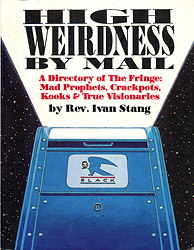1960s
Fish Advertising
In 1961, the French patent office granted Robert-Oropei Martino a patent for a method of placing advertisements on fish. From his patent (translated via Google Translate):It is obviously possible to imagine many ways of having advertising carried by fish. According to the invention, a corset is preferably used, made to the dimensions of the subject in a material that is sufficiently flexible not to hinder it, and which is closed on it by any appropriate means. Such a corset can advantageously be made of plastic and it is possible to conform it to any profile deemed desirable. Preferably, to allow the fish complete freedom to flex its body around a vertical axis, the corset itself is provided with a very small width and is extended towards the rear or towards the front by panels or strips that are entirely free from each other and on which any desired printing or design can be provided. The attached drawing, given as an example, will allow a better understanding of the invention, the characteristics that it presents and the advantages that it is likely to provide...
It is understood that many corset conformations can be imagined, in particular depending on the anatomical conditions of the fish. Instead of using a complete corset properly speaking, it would obviously be possible to arrange a half corset visible on one side only and fixed in place in any appropriate manner, or even a simple panel suitably attached to the body of the fish.
On the other hand, although it seems advantageous to present the fish in an aquarium, the invention could also be implemented with fish placed in a pond or a body of water, the important thing being simply that the fish is perfectly visible and that the corset or other support that it carries can be clearly distinguished and detailed by the spectators.
More info: Patent No. FR1258965 (espacenet.com)

Posted By: Alex - Tue Oct 22, 2024 -
Comments (0)
Category: Advertising, Fish, 1960s
The Letkiss
One of the weirder life-of-a-mayfly dance trends of the 1960s.



Posted By: Paul - Sat Oct 19, 2024 -
Comments (1)
Category: Fads, 1960s, Dance, Europe
The Ring-O Pool Table
One hole only. Learn more here, at the site dedicated to the inventor, Irving Kaye.

Posted By: Paul - Wed Oct 16, 2024 -
Comments (1)
Category: Eccentrics, Inventions, Sports, 1960s
46 reasons not to use LSD
The "46 reasons" were actually one reason based on flawed science.A 1967 study had shown that LSD could cause a two-fold increase in chromosomal breaks in cell cultures. But subsequent studies showed that the breaks were a result of the concentrations of the drug being used — and that pretty much ANY substance, in similar concentrations, would cause chromosomal breaks. In fact, there was no evidence that LSD caused significant chromosomal breaks or was a carcinogen.
More info: Science News

March of Dimes - 1968
Posted By: Alex - Sat Oct 12, 2024 -
Comments (1)
Category: Drugs, Psychedelic, Science, Advertising, 1960s
A Lesson In Love
The creator's Wikipedia page.

Posted By: Paul - Sat Oct 12, 2024 -
Comments (3)
Category: Humor, Self-help Schemes, Vinyl Albums and Other Media Recordings, Psychology, 1960s
Air-Conditioning the Outdoors

House Beautiful - Oct 1966
Posted By: Alex - Fri Oct 11, 2024 -
Comments (0)
Category: Advertising, 1960s
Mr. President Game
Just in case you have not gotten your fill of politics this year, why not search out a copy of the Mr. President Game and play a few rounds?Visit Board Game Geek for details.


Posted By: Paul - Tue Oct 01, 2024 -
Comments (0)
Category: Games, Politics, 1960s
Follies of the Madmen #607
Next time a female police officer stops you, ask if she's wearing Eiderlon panties.
Posted By: Paul - Mon Sep 30, 2024 -
Comments (1)
Category: Fashion, Underwear, Advertising, 1960s
Secrets of Successful Varmint Calling
Secrets of Successful Varmint Calling, by Johnny Stewart, was released in 1967. I could only find a brief clip from it, but I pasted an article below with some more tips on varmint calling.Here in Phoenix you don't need any special trick to find varmints (aka coyotes). Just go for a walk in the early morning and you're bound to see one.


Fort Worth Star-Telegram - Aug 5, 1984
Posted By: Alex - Sun Sep 29, 2024 -
Comments (2)
Category: Animals, Hunting, Trapping and Other Wilderness Activities, Vinyl Albums and Other Media Recordings, 1960s
The effect of humming on vision
A Dec 1967 article ("Effect of humming on vision") by William Rushton in the journal Nature reported that:I'm sure that's interesting, but it's a response to Rushton's article published four months later that I find more interesting. A former member of the Air Training Corps described how it was possible, by humming (or rather, "purring"), to make your head vibrate such that, when looking at a spinning propeller, the propeller would seem to stop in mid-air. By increasing or decreasing the intensity of humming/purring, one could then determine in which direction the propeller was rotating.
I haven't tested this out to see if it works, but if any of you do have a chance to test it out, please report back with your results.

Nature - Apr 20, 1968
Posted By: Alex - Fri Sep 27, 2024 -
Comments (2)
Category: Science, Air Travel and Airlines, 1960s, Eyes and Vision

| Who We Are |
|---|
| Alex Boese Alex is the creator and curator of the Museum of Hoaxes. He's also the author of various weird, non-fiction, science-themed books such as Elephants on Acid and Psychedelic Apes. Paul Di Filippo Paul has been paid to put weird ideas into fictional form for over thirty years, in his career as a noted science fiction writer. He has recently begun blogging on many curious topics with three fellow writers at The Inferior 4+1. Contact Us |




